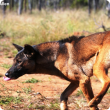Acts
Biosecurity and Agriculture Management Act 2007
Filter by search
Filter by topic
- (-) Remove Control methods filter Control methods
- Pests, weeds & diseases (16) Apply Pests, weeds & diseases filter
- Chemicals (12) Apply Chemicals filter
- Biosecurity & quarantine (12) Apply Biosecurity & quarantine filter
- Biosecurity (11) Apply Biosecurity filter
- Pests (10) Apply Pests filter
- Livestock & animals (7) Apply Livestock & animals filter
- Pest animals (6) Apply Pest animals filter
- Livestock management (6) Apply Livestock management filter
- Livestock biosecurity (6) Apply Livestock biosecurity filter
- Preventing residues (5) Apply Preventing residues filter
- Pest mammals (5) Apply Pest mammals filter
- Invasive species (5) Apply Invasive species filter
- Residues in livestock (4) Apply Residues in livestock filter
- Baits & poisons (4) Apply Baits & poisons filter
- Livestock species (3) Apply Livestock species filter
- Mechanical, physical and cultural (3) Apply Mechanical, physical and cultural filter
- Diseases (3) Apply Diseases filter
- Pest insects (2) Apply Pest insects filter
- Sheep (2) Apply Sheep filter
- State Barrier Fence (2) Apply State Barrier Fence filter
- Veterinary chemicals (2) Apply Veterinary chemicals filter
- Strychnine (2) Apply Strychnine filter
- Management & reproduction (2) Apply Management & reproduction filter
- Livestock health & diseases (2) Apply Livestock health & diseases filter
- Livestock disease surveillance (2) Apply Livestock disease surveillance filter
- Beef cattle (2) Apply Beef cattle filter
- 1080 (2) Apply 1080 filter
- Food, export & investment (2) Apply Food, export & investment filter
- Emergency animal disease preparedness (2) Apply Emergency animal disease preparedness filter
- Poultry & birds (1) Apply Poultry & birds filter
- Livestock movement & identification (1) Apply Livestock movement & identification filter
- Quarantine (1) Apply Quarantine filter
- Plant biosecurity (1) Apply Plant biosecurity filter
- Weeds (1) Apply Weeds filter
- Wildlife biosecurity (1) Apply Wildlife biosecurity filter
- Investment attraction (1) Apply Investment attraction filter
- Stockfeed (1) Apply Stockfeed filter
- Residues in crops (1) Apply Residues in crops filter
- Grains (1) Apply Grains filter
- Crops (1) Apply Crops filter
- Birds (1) Apply Birds filter
- Baiting & poison permits (1) Apply Baiting & poison permits filter
- Emergency response (1) Apply Emergency response filter
- Food & beverages (1) Apply Food & beverages filter
- Insecticides (1) Apply Insecticides filter
- Food safety (1) Apply Food safety filter
- Intrastate movement (1) Apply Intrastate movement filter




